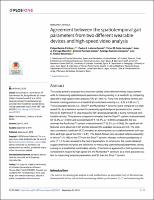Please use this identifier to cite or link to this item:
https://repositorio.usj.es/handle/123456789/267
| Title: | Agreement between the spatiotemporal gait parameters from two different wearable devices and high-speed video analysis |
| Authors: | García-Pinillos, Felipe



Latorre-Román, Pedro Á. 


Soto-Hermoso, Víctor M. 


Párraga-Montilla, Juan A. 

Ramírez-Campillo, Rodrigo 


Roche-Seruendo, Luis Enrique 


|
| Keywords: | RunScribe™; Stryd™; Spatiotemporal parameters; Running at comfortable velocity |
| Issue Date: | 24-Sep-2019 |
| Publisher: | Daniel Boullosa, University of Brasilia, BRAZIL |
| Citation: | García-Pinillos F, Latorre-Román PÁ, Soto-Hermoso VM, Párraga-Montilla JA, Pantoja-Vallejo A, Ramírez-Campillo R, et al. (2019) Agreement between the spatiotemporal gait parameters from two different wearable devices and high-speed video analysis. PLoS ONE 14(9): e0222872. https://doi.org/10.1371/journal.pone.0222872 |
| Abstract: | This study aimed to evaluate the concurrent validity of two different inertial measurement units for measuring spatiotemporal parameters during running on a treadmill, by comparing data with a high-speed video analysis (VA) at 1,000 Hz. Forty-nine endurance runners performed a running protocol on a treadmill at comfortable velocity (i.e., 3.25 ± 0.36 m.s-1). Those wearable devices (i.e., Stryd™ and RunScribe™ systems) were compared to a high-speed VA, as a reference system for measuring spatiotemporal parameters (i.e. contact time [CT], flight time [FT], step frequency [SF] and step length [SL]) during running at comfortable velocity. The pairwise comparison revealed that the Stryd™ system underestimated CT (5.2%, p < 0.001) and overestimated FT (15.1%, p < 0.001) compared to the VA; whereas the RunScribe™ system underestimated CT (2.3%, p = 0.009). No significant differences were observed in SF and SL between the wearable devices and VA. The intra class correlation coefficient (ICC) revealed an almost perfect association between both systems and high-speed VA (ICC > 0.81). The Bland-Altman plots revealed heteroscedasticity of error (r2 = 0.166) for the CT from the Stryd™ system, whereas no heteroscedasticity of error (r2 < 0.1) was revealed in the rest of parameters. In conclusion, the results obtained suggest that both foot pods are valid tools for measuring spatiotemporal parameters during running on a treadmill at comfortable velocity. If the limits of agreement of both systems are considered in respect to high-speed VA, the RunScribe™ seems to be a more accurate system for measuring temporal parameters and SL than the Stryd™ system. |
| URI: | https://repositorio.usj.es/handle/123456789/267 |
| ISSN: | 1932-6203 |
| Appears in Collections: | Artículos de revistas |
Files in This Item:
| File | Description | Size | Format | |
|---|---|---|---|---|
| journal.pone.0222872.pdf | 958,03 kB | Adobe PDF |  View/Open |
This item is licensed under a Creative Commons License

